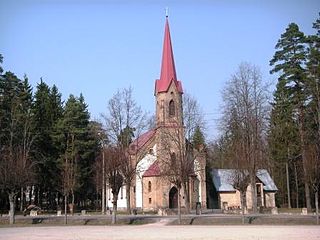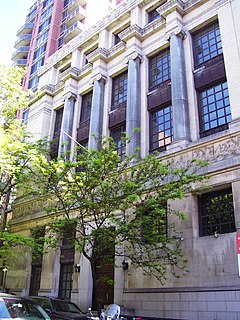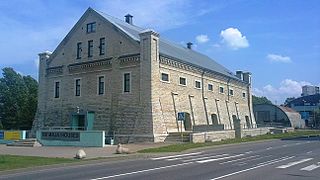
Tallinn is the most populous, primate, and capital city of Estonia. Situated on a bay in north Estonia, on the shore of the Gulf of Finland of the Baltic Sea, Tallinn has a population of 444,532 and administratively lies in the Harju maakond (county). Tallinn is the main financial, industrial and cultural centre of Estonia. It is located 187 kilometres (116 mi) northwest of the country's second largest city Tartu, however only 80 kilometres (50 mi) south of Helsinki, Finland, 320 kilometres (200 mi) west of Saint Petersburg, Russia, 300 kilometres (190 mi) north of Riga, Latvia, and 380 kilometres (240 mi) east of Stockholm, Sweden. From the 13th century until the first half of the 20th century Tallinn was known in most of the world by variants of its other historical name Reval.

Ogre is the state city in Ogre Municipality in the Vidzeme region of Latvia, 36 kilometres east of the capital Riga, situated at the confluence of the Daugava and Ogre rivers. It has been a city since 1928. The population in 2020 was 23,273.

The State Tretyakov Gallery is an art gallery in Moscow, Russia, the foremost depository of Russian fine art in the world.

The College of Fine and Applied Arts (FAA) is a multi-disciplinary art school at the University of Illinois at Urbana–Champaign.

Edgar Johan Kuusik was an Estonian architect and furniture and interior designer.

The New York School of Applied Design for Women, established in 1892, was an early design school for women in New York City. The New York School of Applied Design building was built in 1908 and is now a landmarked building.

The Moravian Gallery in Brno is the second largest art museum in the Czech Republic, established in 1961 by merging of two older institutions. It is situated in five buildings: Pražák Palace, Governor's Palace, Museum of Applied Arts, Jurkovič House and Josef Hoffmann Museum. Since 1963 the gallery has organized the International Biennial of Graphic Design Brno.

The Estonian Academy of Arts is the only public university in Estonia providing higher education in art, design, architecture, media, art history and conservation-restoration. It is based in Tallinn.

The Estonian National Museum founded 1909 in Tartu is a museum devoted to folklorist Jakob Hurt's heritage, to Estonian ethnography and folk art. The first items for the museum were originally collected in the latter part of the 19th century.

Architecture is both the process and the product of planning, designing, and constructing buildings or other structures. Architectural works, in the material form of buildings, are often perceived as cultural symbols and as works of art. Historical civilizations are often identified with their surviving architectural achievements.
Tomomi Hayashi is a Japanese-Estonian architect.

William Nichols, Sr. was an English-born architect who emigrated to the United States and became most famous for his early Neoclassical-style buildings in the American South. He is best known for designing early statehouses for North Carolina, Alabama and Mississippi.

Kadriorg Palace is a Petrine Baroque palace built for Catherine I of Russia by Peter the Great in Tallinn, Estonia. Both the Estonian and the German name for the palace means "Catherine's valley". It was built after the Great Northern War for Nicola Michetti's designs by Gaetano Chiaveri and Mikhail Zemtsov. The palace currently houses the Kadriorg Art Museum, a branch of the Art Museum of Estonia, displaying foreign art from the 16th to 20th centuries. The KUMU branch of the museum, showing Estonian art from the 18th century onwards is located nearby in the park.

Vohnja is a village in Kadrina Parish, Lääne-Viru County, in northeastern Estonia. It lies on the left bank of the Loobu River.

Muuga is a village in Vinni Parish, Lääne-Viru County, in northeastern Estonia. Between 1992–2017 the village was located in Laekvere Parish.
Valve Pormeisternée Ulm was an Estonian landscape architect who became an architect. She was one of the first women to influence the development of Estonian architecture, becoming one of the country's most inventive modernisers of rural architecture in the 1960s and 1970s. She is often known as the "Grand Old Lady" of Estonian architecture.

The Estonian Knighthood House is a building in Toompea, the upper part of Vanalinn, the historic inner town of Tallinn, the capital of Estonia. Its address is Kiriku plats 1. The Dome Church is situated at the same square.

Gulbene is a town in northeastern Latvia. It is an administrative center of Gulbene Municipality.

Raadi Manor was in the area known as Raadi-Kruusamäe, on the outskirts of Tartu in Estonia. The manor and Raadi Manor Park were the home to the Liphart noble family who were significant art collectors. The family moved away and the buildings housed the Estonian National Museum until the manor was destroyed during the Second World War. Part of the grounds became Raadi Airfield which was used as a secret Soviet bomber base for fifty years. Today the park is open, some buildings are in use by the museum and plans are underway to create a new museum building here.

Museum of Estonian Architecture is an architecture museum in Tallinn, Estonia. It is located in the Rotermann quarter. The museum is a member of ICAM.



















